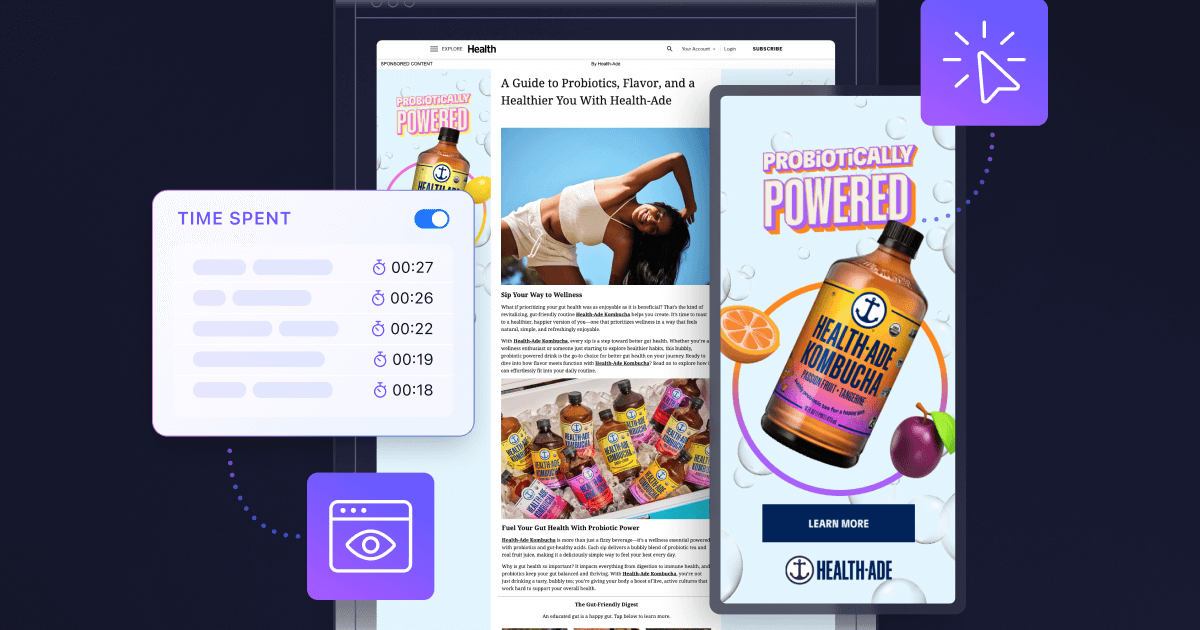What Is a Contextual Targeting Marketing Strategy?
.png)
As our industry moves closer to a reality devoid of third-party cookies, contextual targeting marketing strategies are being pursued with greater diligence and intensity. Although contextual targeting isn’t new to the digital landscape by any stretch of the imagination, it does represent a larger opportunity than ever before.
In this blog post, we’ll discuss contextual marketing, why it’s so important right now, and how marketers can ensure they’re making the most of this important strategy.
What Is Contextual Targeting?
Contextual targeting is a strategic marketing approach that involves delivering tailored advertisements or content to users based on the context of the content they are currently engaging with. Unlike demographic or psychographic targeting, which focuses on audience characteristics, contextual targeting emphasizes the relevance of the content itself. This strategy takes into consideration the keywords, themes, and overall subject matter of the webpage, app, or other digital platform where the user is present. By aligning advertisements with the context of the surrounding content, marketers aim to enhance the overall user experience and increase the likelihood of capturing the user's attention at a moment when their interest is particularly piqued.
One of the key benefits of contextual targeting is its ability to deliver more relevant and timely messages to users. For instance, an online article discussing travel destinations may feature advertisements for travel-related products or services. This ensures that the advertising content is closely related to the user's current interests and engagement, making it more likely to resonate and drive desired actions. Contextual targeting can be implemented through various channels, including display advertising, native advertising, and video advertising, allowing marketers to reach their audience in a contextually relevant manner across different digital touchpoints.
To effectively implement contextual targeting, marketers often leverage advanced technologies, such as machine learning algorithms, natural language processing, and sentiment analysis. These tools enable the automatic analysis of content context and help identify the most suitable moments for delivering targeted messages.
Why Is Contextual Targeting Important Now?
Contextual targeting has become more important now than in the past due to several significant shifts in the digital landscape and consumer behavior:
- Ad Blockers and Privacy Concerns: With the rise of ad blockers, the deprecation of third-party cookies, and increased awareness of privacy issues, traditional methods of targeting based on user data have faced challenges. Contextual targeting provides a privacy-friendly alternative, as it relies on the content context rather than personal information. This aligns with evolving regulations and consumer expectations regarding data protection.
- Content Overload and Fragmentation: The internet has seen an explosion of content across various platforms and formats. As users are bombarded with information, contextual targeting helps cut through the noise by delivering relevant messages at the right moment. This ensures that advertisements align with the user's current interests, making them more likely to capture attention in a crowded digital space.
- Real-Time Personalization: Advances in technology, particularly machine learning and artificial intelligence, have empowered marketers to implement real-time personalization at scale. Contextual targeting leverages these technologies to analyze content context and user behavior in real-time, allowing for more immediate and precise delivery of personalized messages.
- Content-First Approach: The shift towards a content-first approach in digital marketing emphasizes the importance of delivering value through relevant and engaging content. Contextual targeting aligns with this strategy by ensuring that advertisements complement the surrounding content, creating a more cohesive and enjoyable user experience. Brands are recognizing that contextually relevant content is more likely to resonate with audiences, fostering positive associations.
By focusing on the context of content, marketers can deliver more relevant and timely messages, ultimately improving the effectiveness of their campaigns in today's rapidly evolving digital landscape.
How Can Marketers Make the Most of Contextual Targeting Opportunities?
Advertiser spend on contextual targeting will grow impressively in the coming years. To make the most of contextual targeting as a marketing strategy, marketers need to adhere to a few guidelines to enhance the effectiveness of their campaigns and connect with their audiences:
- Leverage Advanced Technologies: Work with partners that enable you to tap into machine learning and natural language processing algorithms to analyze content context in real-time. These technologies can help identify relevant keywords, themes, and sentiments, improving the accuracy of contextual targeting.
- Understand Your Audience: Develop a deep understanding of the target audience and their preferences. By knowing the interests and behaviors of the audience, marketers can align contextual targeting efforts and the content of campaigns with the most relevant and engaging destinations online.
- Dynamic Creative Optimization: Use dynamic creative optimization to customize ad creatives based on the context of the content and user behavior. Tailoring visuals and messaging in real-time can significantly enhance the impact of the advertisement.
- Multichannel Integration: Implement contextual targeting across various channels and platforms to create a cohesive and integrated marketing strategy. This ensures a consistent and contextually relevant experience for users, whether they are on social media, websites, or mobile apps.
- A/B Testing: Conduct A/B testing to evaluate the performance of different contextual targeting strategies. Experiment with variations in ad copy, visuals, format, and placement to determine what resonates most effectively with the target audience in specific contextual settings.
- Strategic Placement: Choose platforms and premium placements carefully to maximize the impact of contextual targeting. Understanding where your audience is most likely to engage with relevant content allows for more precise targeting and higher conversion rates.
By adopting these guidelines for strong contextual programs, marketers can unlock the full potential of contextual targeting, delivering more engaging and personalized experiences to their audience.

.jpg)


